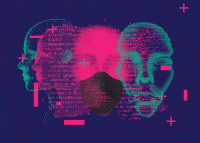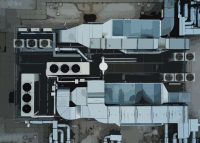The words that came from my mouth were unbelievable. After being in the construction tech business for nearly 25 years, I was asking everyone in our company — everyone — to collect their necessary belongings and leave the office, not for the night or weekend, but for the foreseeable future. In what felt like an instant, Covid-19 had thrown us from being a company of people who worked together, with teams of folks (including myself) who travel enough to attain gold or platinum status with our most used air carriers, to working almost exclusively from home. How would we survive, much less thrive? And what would the future look like?
For us, the change to a virtual world of working and living, though different, has actually brought some welcome discoveries. Although we’ve had our share of necessary learning and hurdles, the outcome has been surprisingly positive. The vast majority of this realization is the result of two technologies, the first of which is virtual meetings. The second is digital twins, and while they may not be as prominent in our daily vocabulary as Zoom or Teams, they are equally important.
A twin is digitally born
During the late 60s, NASA employed a physical/digital twin of the Apollo spacecraft on earth to help diagnose problems and engineer solutions for the craft thousands of miles away. Obviously, NASA’s approach was cost-prohibitive for most people and businesses, but the benefits, as witnessed by the safe return of the astronauts, were undeniable.
Read more



Digital twin technology has advanced greatly since NASA’s first deployment. In its basic form, a digital twin is the duplication of anything in the real world into the digital realm of computers. But, unlike mere visual simulations, the complete digital twin takes on many of the characteristics of the physical objects and environments they represent.
Now, we are starting to see improvements across industries as more organizations realize the power of digital twins. Initially, these benefits were largely around property and equipment design, energy efficiency, system and process analysis, and maintenance. But they now extend into virtually every area of our lives, in business, at home, and in the community. Digital twins are particularly valuable in combination with Computer Aided Facilities Management (CAFM), the IOT (Internet of Things), and artificial intelligence (AI) driven neural-based information management.
Digital twins are helping cities benefit from improved traffic flow analysis, energy demand balancing to output, and improved collaboration between people, businesses and government. Business can opt to use digital twins in place of spreadsheets as all files and information are effectively stored within the simulated environment. In doing so, they’ll be able to quickly analyze efficiencies in simulated visual spaces to manage predictive maintenance, streamline business operations, offer virtualized new hire training, perform remote management and market to prospective tenants and customers, all from within the virtual environment.
Growing up digital
By the beginning of the 21st century, digital 3D modeling had started to proliferate in some areas of business, particularly in design and engineering, where BIM (Building Information Modeling) went beyond simple lines on drawings, to include the three-dimensional representation of objects, inclusive of embedded object data. The benefits were very real, but the products were too complex for the average user and disparate from one another. As a result, for more than twenty years these programs were largely relegated to a small group of designers, engineers, and modeling experts. But a younger generation of users was entering the scene. These “players” were growing up with computer gaming that allowed simple, first-person, real time interaction with virtual worlds and other players from a much more friendly and responsive interface.
As the worlds of engineering, business, and gaming connected, the stage was being set for access by a broader audience. But it is the proliferation of AI that is making the digital twin a more personal experience, creating an interaction that is tailored to our needs and desires in real or near real time.
Digital twins may have started as a complex system to help analyze, manage, and improve properties and business operations, but their story is rapidly changing. Innovative products are now starting to provide benefits that can reach every level and department of business, with user interaction that takes advantage of the learned experiences of gaming to offer simple but powerful user experiences. With the benefit of centralized informational access and the real-time connectivity provided by the connected web of sensors we call the Internet of Things, digital twins now offer very real and attainable value to people and businesses, at home and work.
Get a digital job
There are tons of practical business applications of digital twins in real estate. Even in the pre-COVID-19 world, asking people to visit a property, especially from out of town, is an often-costly hurdle, or at minimum, an environmentally damaging interruption of time. For many businesses it is not uncommon for travel budgets for a portion of the staff to approach or even exceed direct compensation. Whether a technician making a trip to determine equipment for proper parting, salespeople meeting prospective clients at a property, facility managers reviewing staff or production, or owners and managers walking the site while planning a redesign, people who work with buildings spend a significant portion of their time traveling. But now thanks to COVID-19, travel, even down the hall, comes with greater risks. As a result, companies and individuals alike are being thrown into the reality of remote collaboration and management. For some, this will be a disaster, but with the aid of the digital twin it can offer a tremendous opportunity.
A recent seminar at the Getty Center in Los Angeles determined the average lifespan of a conventionally built building (masonry and wood) to be about 120 years, and that of a reinforced concrete and glass curtain wall building (think modern office building) is about 60 years.
When we consider that it generally takes about two years to design and build the average commercial building, we can quickly calculate that the design and construction phase only accounts for about 2 percent of the building lifecycle, yet nearly 100 percent of the information needed to manage a building is collected during design and construction.
While the “plan room” and vast collection of emails and files may contain the information somewhere, the handoff and access to this information is inefficient and starts to become outdated almost as soon as the doors open. But not with the digital twin, where BIM data, information, visuals, and intelligence are all combined into a useful and easily accessible tool that creates significant opportunities for efficiency in the management process.
In these days of restricted travel, social distancing and remote working, a digital twin can play a major role in property management and operations, while also saving time and resources. In the digital twin, every decision that was made during the design can be recorded. The date of equipment installation, the provider, model number, installer, warranties, and service requirements are all stored inside the equipment itself. As history unfolds, maintenance is performed, copy toner runs low, spaces are remodeled, and all of this can be managed and recorded in the digital twin.
Creation of the virtual model can occur for existing properties in a few ways. If 3D models were used in the design process, these models can be translated into a digital twin environment. If only 2D drawings were created, the owner can have the drawings translated into a compatible 3D model, or use laser scanned and photo-based imagery (photogrammetry) to provide the necessary input. Currently, translating from 2D is often less costly than laser scanning, but if very high precision is necessary, laser scanning with photogrammetry provides incredible detail. And the cost for these services is rapidly dropping.
The digital golden years
In the virtual world, the information and history of a facility, equipment, human resources, and other critical data can be accessed in moments. This has lots of important benefits in all aspects of the property industry. In leasing, it’s easy to recognize the benefits of having a virtual model that people can walk through and experience in first person. This is especially true when these models start to take on characteristics of the property and surrounding community that go beyond visual imagery to inspire real experiences and emotional response.
For the marketing agent, without making a single phone call or forcing people to read boring lists and thumb through pictures, potential customers and tenants can walk onto a virtual patio and hear the music from the amphitheater while birds fly and sing overhead, or look out to see inviting signs rise to show local restaurants and bike trails. Friendly avatars can lead property tours that the participant can influence based on their own desires and interests, without owners having to pay full time staff to provide the tours or asking visitors to wait for the next available person. Visitors can provide real-time feedback of interests, what they like (or don’t care for) and ask questions, with the information collected using virtual intelligence to recognize trends and opportunities. What I describe might sound a bit science fiction, but this is all achievable right now, with technology that has already been developed.
Thanks to the digital twin, new and potential hires can be trained on new facilities and equipment from anywhere in the world and tested on their knowledge. Staff can collaborate on design efficiencies and safety, offering potential design improvements. By monitoring traffic flow and air quality, tasks like cleaning public restrooms can be based on real-time need, instead of random schedules. Equipment monitoring can be the difference between replacing a $10 bearing during off-peak times or losing thousands of dollars in down equipment repairs and process interruption. There are even use cases evolving for insurance — with some claims and bidding on repairs taking place within a digital twin.
For the manager and employee alike, digital twins can create connectivity across all properties and into every team. Tasks can be created, assigned, and tracked to keep remote teams aligned with business priorities and needs. Customers, businesses, and communities can be more connected and informed.
The benefits offered by digital twins have the opportunity to go well beyond the obvious costs and time savings advantages of travel reduction, providing a plethora of opportunities that the physical space simply cannot. In this time, when many of us are working virtually and with restricted travel, digital twins may be our single greatest opportunity to thrive. We all have to make the best of this new situation Although I may miss greeting the TSA agents and eating airline lounge food, I know these changes are going to accelerate the adoption and development of this important technology. This is just the beginning of a journey that promises to positively impact our lives and our businesses in more ways than we can even imagine — and I believe that we are ready for the challenge. [Propmodo]
The writer, Mitch Hughes, is the founder and CEO of ViZZ and a senior partner at VirTeca.
